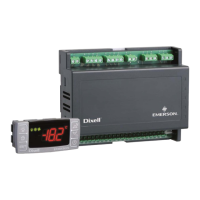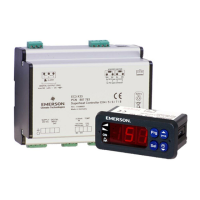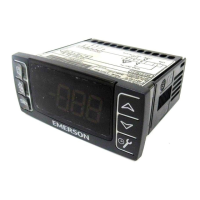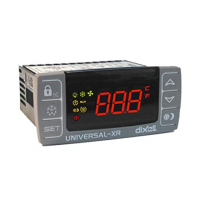Document Part # 026-4280 Rev 1 Page 19 of 33
©2022 Emerson Digital Cold Chain, Inc. This document may be photocopied for personal use.
Visit our website at www.climate.emerson.com for the latest technical documentation and updates.
rPd
Temperature Regulation Strategy: (rPA, rAb, Aur, LoE, HiE. )
rPA: Temperature detected by the probe set in the parameter rPA.
rAb: Mix between rPA and rPb defined by rPE parameter.
AUr: Average temperature of all the probes defined as Regulation Probe in the parameters rPA, rPb,
rP3, rP4.
LoE: Minimum value among all the temperature probes defined as Regulation Probe in the parameters
rPA, rPb, rP3, rP4.
HiE: Maximum value among all the temperature probes defined as Regulation Probe in the
parameters rPA, rPb, rP3, rP4.
rPE
Regulation virtual probe percentage: (0 to 100%) it defines the percentage of the rPA respect to rPb.
The value used to regulate room temperature is obtained by:
Value_for_room = (rPA*rPE + rPb*(100-rPE))/100
DEFROST
dPA Defrost Probe A: (nP; P1; P2, P3, P4, P6) first probe used for defrost.
dPb Defrost Probe B: (nP; P1; P2, P3, P4, P6) second probe used for defrost.
tdF
Defrost type: (Air, EL, in)
Air = Air defrost (relay is not switched on during defrost)
EL = Defrost with electrical heater.
in = Hot gas defrost.
EdF
Defrost mode: (rtc – in- Aut) (only if RTC is present) rtc = defrost activation via RTC; in = defrost
activation with idf; AUt = on demand defrost.
Srt
Heater setpoint during defrost: (-55.0 to 150.0°C; -67 to 302°F) if tdF = EL during the defrost the
defrost relay perform an ON/OFF regulation with Srt as setpoint.
Hyr Differential for heater: (0.1°C to 25.5°C, 1°F to 45°F) the differential for heater.
tod
Time out for heater: 0 to 255 minutes if the defrost probe temperature is bigger than Srt for all tod
time the defrost ends although the defrost probe temperature is lower than dtE or dtS. It permits to
reduce defrost duration.
d2P
Defrost with two probes: (N – Y) N = only the dPA probe is used to defrost management; Y= defrost
is managed with dPA probe and dPb probe. Defrost can performed only if both probe value are lower
than dtE for dPA probe and dtS for dPb probe.
dtE
Defrost termination temperature (Probe A): (-55,0 to 50,0°C; -67 to 122°F) (Enabled only when the
evaporator probe is present) sets the temperature measured by the evaporator probe dPA which
causes the end of defrost.
dtS
Defrost termination temperature (Probe B): (-55,0 to 50,0°C; -67 to 122°F) (Enabled only when the
evaporator probe is present) sets the temperature measured by the evaporator probe dPb which
causes the end of defrost.
IdF
Interval between defrosts: (0 to 120 hours) Determines the time interval between the beginning of
two defrost cycles.
idE
Time to next defrost log into not volatile memory
No: Time to next defrost is not logged into no volatile memory, this means controller will use the idF
interval after a power off. E.I. idF = 8: controller performs a defrost every 8 hours. If controller is
switched off, independently from when last defrost happened, at power on it will do the first defrost
after 8 hours.
Yes: Time to next defrost is logged into no volatile memory, this means controller will use it after a
power off. E.I. idF = 8: controller performs a defrost every 8 hours. If controller is switched off 6 hours
after last defrost, at power on it will do the first defrost after 2 hours (6+2 = 8). It is useful in places
subjected to frequent power outages.
ndt
Minimum duration of defrost: (0 to MdF minutes) it sets the minimum defrost duration,
independently form the temperature reached by the end defrost probes.
Parameter Description
Table 13-1 - Parameter List

